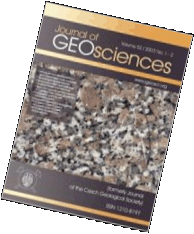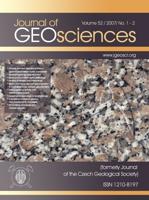 Export to Mendeley
Export to MendeleyMore articles on Deep crustal metamorphism and lower-crustal/upper-mantle processes
Original Paper
The Sklené garnet peridotite: petrology, geochemistry, and structure of a mantle-derived boudin in Moldanubian granulite
Journal of Geosciences, volume 54 (2009), issue 4, 301 - 323
DOI: http://doi.org/10.3190/jgeosci.052
The Moldanubian Sklené garnet peridotite, which preserves mineralogical, geochemical, and structural evidence for a protracted mantle evolution, is a small boudin (~1 m) enclosed by granulite of the Gföhl Assemblage. The peridotite has a porphyroclastic texture, in which large garnet and smaller olivine and pyroxene porphyroclasts (Stage 1) reside in a fine-grained, recrystallized matrix of olivine, pyroxene, and pargasitic amphibole (Stage 2). Garnet is surrounded by kelyphite, consisting of an outer zone of pargasite and an inner zone of spinel and pyroxene (Stage 3).
Lattice-preferred orientations (LPO) for olivine, orthopyroxene, and clinopyroxene were measured by electron backscatter diffraction. The LPO of olivine (mostly Stage 2) has an [010] maximum parallel to the Z fabric direction and [100] and [001] girdles in the X-Y fabric plane. Both orthopyroxene and clinopyroxene have [010] maxima parallel to Z and [001] girdles in the X-Y plane.
The Sklené peridotite is slightly depleted in incompatible major and minor elements relative to primitive mantle. Whole-rock REE contents are 0.3 to 0.8 times that of primitive mantle, with a convex upward pattern, and Rb, Th, U, Pb, and Sr show positive anomalies in an extended element plot. Among the highly siderophile elements, Os, Ir, Ru, and Pt are unfractionated, but Pd and Re are significantly depleted. A Sm-Nd garnet-whole rock-clinopyroxene isochron yields a cooling age of 338 ± 13 Ma, and εNd and (87Sr/86Sr)i values for clinopyroxene (at 335 Ma) are +4.5 and 0.7035, respectively.
By comparison with other Moldanubian garnet peridotites in the Czech Republic, the Sklené peridotite likely represents a fragment of subcontinental lithospheric mantle. It experienced early partial fusion and depletion of incompatible elements at moderate pressure in the spinel stability field, followed by transport to high-pressure conditions at 1230 °C and 50 kbar, where the Stage 1 garnet-bearing assemblage was stabilized. Subsequently, the depleted peridotite was metasomatized by transient, primitive basaltic melts, with the addition of Rb, Th, U, Pb, and Sr. Dynamic recrystallization, possibly with a progressive transition to grain size sensitive creep, occurred during Stage 2 at ~915 °C and 24 kbar in a flattening-dominated, transpressive deformation regime. This event occurred prior to incorporation of the peridotite in granulite and may reflect the early stages of convergence between Brunia and Moldanubia. The static recrystallization and local growth of spinel within kelyphite at 900 °C and 17-21 kbar (Stage 3) probably took place after entrainment in granulite and was likely isofacial with granulite peak metamorphism.
Webdesign inspired by aTeo. Hosted at the server of the Institute of Petrology and Structural Geology, Charles University, Prague.
ISSN: 1803-1943 (online), 1802-6222 (print)
email: jgeosci(at)jgeosci.org


IF (WoS, 2024): 1.3
5 YEAR IF (WoS, 2024): 1.4
Policy: Open Access
ISSN: 1802-6222
E-ISSN: 1803-1943